The Fir Tree Inn – 1950 to Present
This is the fourth and final part of the Fir Tree Inn story, taking it through my parents time there and up-to-date.
Sidney Hughes did a little advertising for the pub, with the page illustrated below in the local Rail and Bus Guide for Stony Stratford and Wolverton in 1951, but later that year, he retired. From The Woburn Reporter, 21st August 1951:
“Leaving Woburn Sands – Host and hostess of the Fir Tree Hotel, Woburn Sands, since 12th August 1933, Mr. and Mrs. S. Hughes relinquish that position on Friday 24th August. They will then leave Woburn Sands for Delabole, North Cornwall, and will live in retirement. Mr. Hughes’s health not having been too good during the past few years. During their 13 years’ management the good reputation of the Fir Tree Hotel has been maintained, and Mr. and Mrs. Hughes have always been popular and courteous when attending to both visitors and local customers.
Both Mr. and. Mrs. Hughes have been blood donors at the local centre, and Mrs. Hughes was one of the donors on the Woburn Sands panel who received a long-service badge from the Duchess of Marlborough at Rhodes, House, Oxford, on the last day of May 1951.
Mr. Hughes, who had to cease giving blood on doctor’s advice, also qualified for a badge, but did not attend the ceremony at Oxford. He served in the Home Guard during the war, being a member of the Aspley Guise platoon.
New manager of the Fir Tree Hotel will be Mr. A. F. Jenkins, who comes from Dunstable.
Sidney Hughes died in Hendon in 1981.
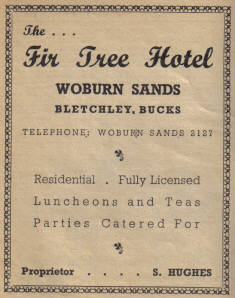
1951 to 1969 – Albert Frederick Jenkins
Albert Jenkins was aged 51 and had been working for Vauxhall Motors prior to taking the pub. His application to Charles Wells’ Brewery says he had experience through helping out at the Nags Head in Dunstable. The brewery also wanted details of their applicant’s war service record and he’d served as a Sergeant with the Queen’s Own Cameron Highlanders in the First World War. The rent for the pub was £40 p.a., but pointed out that there was no gas connected, with cooking and heating being done by an Aga range. Jenkins paid £30 to Hughes for the fixtures and fittings. In order to prevent outgoing landlords from taking all their customers with them, the contact had a standard clause that the old tenant was barred from taking any licensed premises within 3 miles for 3 years, or they had to pay the new landlord £75!
Jenkins also advertised the pub, but when he put a page in a booklet about the North Bucks Beagles, a local hunting group, who had kennels at North Crawley, he used the same photo as Harold Clements had used in the 1930’s.
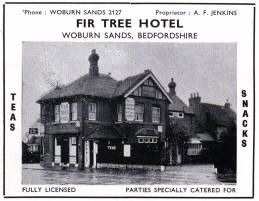
Two photos of the Remembrance Sunday parades, (1955 and 1958) with Fir Tree in the background. The 1955 one is the earliest photo I have seen where the outside of the pub has been painted, which was done in about 1951.
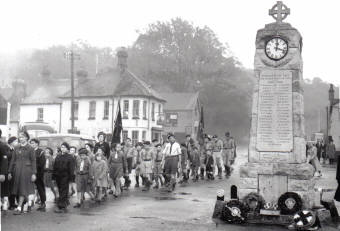
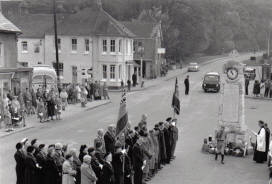
A better picture appears in “Tankard Trails”, a guide to Charles Wells’ pubs, published in 1959. This is before the toilet block was added. The text reads: “As we drive through Woburn Sands on our way to Woburn Abbey, the Fir Tree is conspicuous at the foot of the hill that takes us into a belt of pine country – alas, without any grizzly bears, unless indeed the Duke of Bedford keeps a brace in his famous Zoo Park. This is a good half crown’s worth from the end of March to October, although the house itself is open on Sunday afternoons all the year round.”
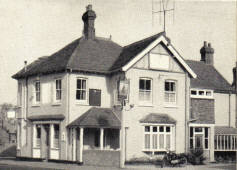
Also in 1959, local auctioneers and estate agents Foll & Parker published a map of Woburn Sands and District to attract buyers to the area, which featured this ad from Jenkins:
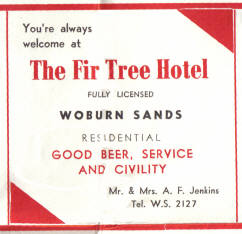
In 1960, there was a major remodelling and the flat-roofed toilet block was added to the front of the pub. The building works cost £2720 and the construction took so long that the British Legion had to move their monthly meeting to the local bandroom on Aspley Hill.
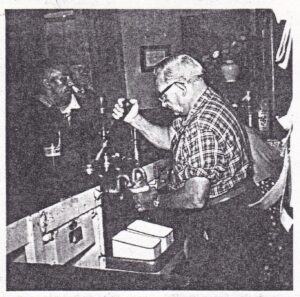
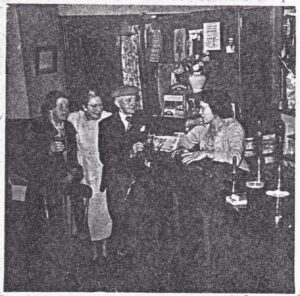
These two photos of Albert and his wife behind the Fir Tree bar were loaned to me by Mary Jenkins, daughter of Albert, when I first started researching the pub in the late 1980s. Sadly, back then, the only option I had to copy them was a photocopier, so they are not very clear and I have since lost touch with her.
Albert’s son operated a business out of the clubroom previously used as for meetings and Catholic services. This was called “Glenwood Products”. He printed company names onto advertising wares and made “Silk Screen Printing and Hot Die Stamping, Novelties, Showcards and Signs” according to his letterheading. [I have a PRIVATE door sign over my office doorway now, taken from the Office door of the Fir Tree when we left, made by his workshop.] The brewery had agreed to fit a toilet into the corner of his factory in 1968 and it had its own separate telephone line. I have seen in local papers that the pub had a darts team around this time, I have to say it was usually rooted to the bottom of the local league table!
Albert Jenkins finally retired in 1969, although his son continued to use the workshop across the car park for several more years.

1969 to 1970 – Ernest Dennis Hodson Lant
The new tenant for the pub was Ernest & Kit Lant, who took over in November. Rent was now set at £208pa. Ernest was born in Bedford in 1923 and he and his wife had previously run the Gate pub, near Cardington Camp and more recently a petrol filling station in Willington. Mrs. Lant was quick to arrange for local art to be displayed on the pub walls, to help local artists.
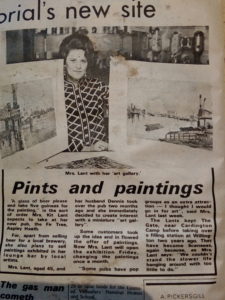
However, Agnes “Kit” Lant later became unwell and they were forced to leave the Fir Tree by July 1970. They moved to Bedford. Ernest died in 2006.
1970 to 1997 – John Harvey Cox
The pub was then taken by an ex-BOAC air steward and his new wife, who had been the Head Housekeeper at the Excelsior Trust House Fortes hotel at Heathrow. They moved up from Englefield Green, London, to take the pub. This was John Harvey Cox and Ursula; my parents. They had looked at several Charles Wells’ pubs in the area, but settled on the Fir Tree as it had the outbuildings to develop into hotel rooms. The rent was £220pa – already £12 higher than it had been six months before. The business agent’s original letter to them reads:
“Further to your recent application to us for the tenancy of Licensed premises in this area we can inform you that we have been asked to find a new tenant for the ‘Fir Tree’, a fully licensed public occupying a splendid position in the centre of the township of Woburn Sands, on the Beds/Bucks borders, only about 4 miles from Bletchley, 2 miles from Woburn and on the fringe of the new City of Milton Keynes.
The premises are held on usual tenancy from most popular Brewers at a rental of only £220 per annum, with Rating Assessments £190 Gross and £138 Net.
The house has some good accommodation, with Off Sales Dept., Public Bar, Games Room, Lounge Bar, Servery, Cellar, Kitchen, 5 Bedrooms, Bathroom, Yard with outbuildings and Car Park.
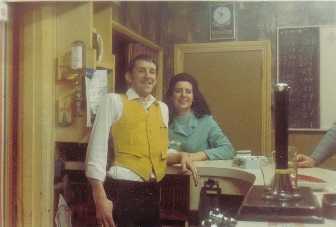
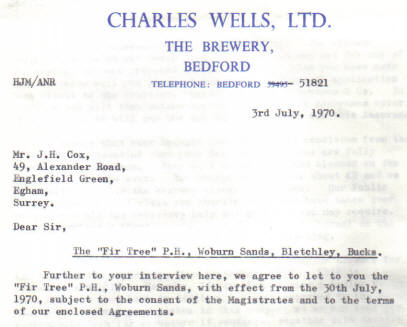
The Brewers have recently given instructions for the remodel of the present Kitchen, in order that meals can be prepared. Access will also be made to the present Lounge Bar, so that this could act as a small semi-dining room. The house is due to be redecorated in the Spring of 1972.
The house has been in the same hands since November, 1969, but the present licensee has reluctantly been compelled to give notice, owing to the ill-health of his wife, and since his occupation the trade has considerably been increased.
The figures of trade for the year ending 31st December, 1969, are as follows: 105½ Barrels of Cask Beers, 37½ Gallons Spirits, 54½ Barrels of Bottled Beers and 27 Gallons Wines.
There is also a useful trade carried on with Sundries and Mineral Waters, and the present licensee is establishing a catering business Bed and Breakfast trade can also be carried on at this house.”
The inventory that they took on from the Lant’s included everything loose in the pub: all furniture, equipment, signs and glasses, as well as “..one bristle dartboard (wearing)“! It was standard practice then that the incoming landlord had to pay in cash for the fixtures and fittings. This had been agreed beforehand at £1200 but on the day, the bill came to £1372 17s 4d. There was much wrangling before the accountants agreed to take a cheque for the remainder covering various licences and charges as my parents only had £1200 in cash available. Anything that they didn’t want from the inventory was put in boxes in the cellar so it could be handed on to the next tenant and claimed for!
When my parents moved in, there was no door between the kitchen and the lounge bar, which they wanted to convert into a proper restaurant. From the outside, Aspley Hill-view of the building, the current kitchen looks like it may have been a separate building at one point. The roof is much lower than the rest of the building. The only way from the existing kitchen into the bars was out through the back door of the kitchen, in through another door into the toilet corridor, then through another door into the bars. The new door was put in and the kitchen completely refitted by September 1970. A couple of the stables were let to a local Vet so he could run consultations three times a week. We were used to seeing a queue of various animals waiting in the car-park at 2.30.
My father sent an article back to BOAC for their staff magazine, about his first experiences of running a pub. There are several references to BOAC terminology in it that I don’t understand, but it gives an idea of how little he knew about the running of a pub! Sadly, I didn’t find this until long after he had died.
“Leave, and ‘Take’ a Pub??” or “How to Pick Hops from your Hair with a Steel Girder”
“It’s a piece of cake” said the ex-RAF man who interviewed us for the Pub. He was referring to the spilling and tapping of a barrel, and the cleaning of antiquated pipes and pumps, (pumps which originated in Noah’s bilges!) We signed the 30,000 official forms (not an AFD or AED among them) and looked as angelic as possible at the local Magistrates Court, in order to obtain a licence to sell “hooch” and “ciggies” on or off the premises of The Fir Tree Hotel at Woburn Sands.
I received my first fair-sized bruise going down the cellar steps. A shelf, designed by the Marquis de Sade, and built by a perfectionist, was cunningly placed at eye-brow level above the steps, halfway down them. It was very easy to locate. I was on my way down to find out why the “best bitter”, which I had been pulling freely for 2 days, had suddenly come to a full stop. After rubbing my head for 2 or 3 minutes I studied the set-up. Pipes in all directions. Nothing remotely resembling Watney’s top pressure super-duper easy-to-operate-type barrels was to be seen. I repeated to myself, “It’s a piece of cake”, and there, lo and behold, was a barrel marked “Eagle”. Now all I had to do was pass the contents therein from cellar to buyer (forgive the pun).
It sounds simple doesn’t it? Make a hole in the top of the barrel and draw the contents out through the bottom by means of the Noah’s pump up above, and a brass tap, which, incidentally, must be securely embedded in the base of the barrel. I found a tap eventually and tripped over a whacking great rubber mallet lying on the floor, which I assumed could only be used for ‘tap-bashing’, or conversely, the previous tenant owned a Zulu warrior to keep the regulars at bay.
At this point, allow me to digress a little and explain exactly what a “regular” is. He (the regular) is a man who has absolutely no sense of time whatsoever. His wrist watch is always wrong by at least 30 minutes, sometimes more, but he swears by it all the same. He won’t even believe in a “Leon Wan” Seiko special, even if they did time the Olympic Games. “No wonder we didn’t win” he’ll say, amidst great hilarity from his mates. But don’t let us run him down, for he spends every penny his wife allows him on beer, baccy and “one armed bandits” (I said, rubbing my sore hands with glee).
Let us return to the saga of extracting the delights of Charles Wells’ Brewery from a barrel. With rubber mallet in one hand and a spile in the other, I proceeded to whack a hole in the top of the barrel. I imagine you have all seen the Trevi Fountain in Rome (if you got past the Wine Cellar). Well, believe me, it had nothing on what I had inadvertently performed. “Best Bitter” hit the ceiling of the cellar with great gusto, and descended (on automatic of course) upon myself. (For those disciples of D. Rumble’s Beer brewers at home, FORGET IT).
Seemingly this act should have been performed 4 days previously. Anyway, to stem the flow of “Publican’s Gold Dust”, I whacked the spile into the barrel and thought to myself, “It’s a **!!?? sight easier to open a can of Carlsberg” or words to that effect. I then grabbed the tap which was, like myself, covered in beer and hops, and proceeded to bash it into the barrel. “You must be joking” I muttered to myself, and whacked harder. At this stage I made an impression, and beer spurted straight out of the barrel on to my right leg, ruining my best ‘strides’ and making the floor better than any ice rink. With one more whack of the mallet, success. I had attained:- one ruined shirt, one pair of sodden strides, and a cellar full of “Best Bitter”. Finally I hitched up the appropriate pipes and was all set to go. As I straightened up and skidded off with all the grace of Sonja Henie slap bang into an iron girder, receiving a near fatal blow upon the scalp which even the hops therein failed to protect.
Fortunately, after much trial and error, I have mastered the art of barrel tapping, and my wife and I have settled down. My draught Guinness, as they say around these here parts is “Moost Boofull”. It must be, because the wife is expecting sometime in May next year. What with that and a young Doberman Pup, I guess I’ll have my hands full.
We will welcome anyone from BOAC but if you need accommodation, please let us know in advance. Up to my neck in beer and ‘fag-ends’ (it’s gone midnight.)
J. H. Cox (Ex rear Galley-Slave)”
This history now becomes family history as well as local history, as I indeed arrived on time in May 1971. By the next year, my parents had finished decorating the new restaurant with all the mementos which my father had brought back from around the world. Friends still with the airline were dispatched with orders for more. Not only had he been an air steward, but he was also a ship’s steward in the Merchant Navy before that. The room was decorated with authentic African tribal art and weapons, with leopard-skin patterned wallpaper and a thatched grass hut-style canopy over the bar. This was to tie-in with the Safari Park at Woburn, a very big local attraction and the first such drive-through park in England. The crowds flocked to the park and the Abbey. On a busy day in the summer, traffic could be queued-up right out of Woburn.
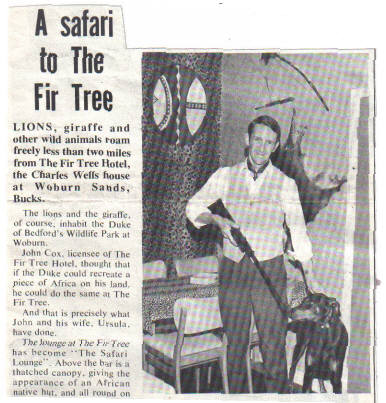
From the Charles Wells trade magazine, “PintPot”, in September 1972:
“A safari to The Fir Tree. Lions, giraffe and other wild animals roam freely less than two miles from The Fir Tree Hotel, the Charles Wells house at Woburn Sands, Bucks. The lions and the giraffe, of course, inhabit the Duke of Bedford’s Wildlife Park at Woburn. John Cox, licensee of The Fir Tree Hotel, thought that if the Duke could recreate a piece of Africa on his land, he could do the same at The Fir Tree. And that is precisely what John and his wife, Ursula, have done. The lounge at The Fir Tree has become “The Safari Lounge”. Above the bar is a thatched canopy, giving the appearance of an African native hut, and all round on the walls are spears, shields, and masks and other symbols of African village life. John, a BOAC airline steward for ten years, was able to carry out his scheme for re-decorating his bar with the help of BOAC friends who brought him trophies back from East and West Africa.
GLOWING MASKS – The lounge really comes into its own at night, when the curtains are drawn to shut out all traces of the English countryside outside, and the African masks glow from strip-lights cunningly concealed behind them. John’s “Safari” scheme was made possible when The Fir Tree became due for redecoration. The Brewery put up wallpaper simulating rush matting, and John and Ursula provided the thatching and all the other decorations, including rush table mats to match the wallpaper. Since the Cox’s moved into The Fir Tree two years ago, they have developed the catering side of the trade, and are becoming well known, both with the locals and among visitors to Woburn Abbey, for their lunches and dinners. They provide a menu ranging from hot pies and vegetables to their house specialities, grilled steak, and duck with orange. Deep-fried chicken and scampi will be making an appearance soon. They also have a respectable wine list – a choice of ten wines. These start at under £1 a bottle, and include two champagnes for customers with something to celebrate.
“SUITCASES” John decided on the publican’s life because after 15 years of “living out of suit cases” – he spent five years in the Merchant Navy before joining BOAC – he wanted to settle down. Ursula, as Executive Housekeeper for six years at the 450-room Fortes Excelsior Hotel at London Airport, had already accumulated plenty of experience of hotel life. Nowadays, at The Fir Tree, she has only three letting bedrooms to look after!”
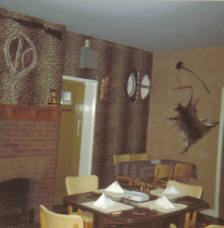
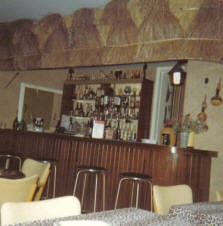
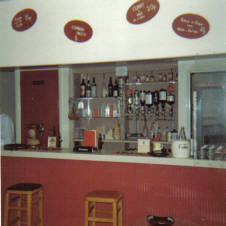
The “three letting bedrooms” were rooms upstairs in the main pub building, which went down to two after I arrived. In 1973, Fred Jenkins Jr. finally left the workshop premises that he had set up in the old clubroom (after a long battle) and the building was reunited with the pub. The brewery agreed that it could be converted for accommodation, at the landlord’s expense, but there were years of negotiations over the increased rent and drawing-up of acceptable plans, so it was not completed for many years. They graciously allowed one years’ free rent of the empty warehouse and then imposed a £100pa rent increase for the extra space, saying that the increase would be £250pa when bedrooms were opened.
At sometime, a wooden garage had been erected under the clubroom, but this was demolished as it was deemed a fire risk to those sleeping above. I can recall going into the derelict clubroom as a child; it was thick with dust and contained nothing but bare floorboards and several dead birds. The small loft over the garage in the corner of the car park also was bare, bar a couple of broken chairs and there was nothing at all in the attic of the pub itself. Successive departing landlords had made sure they left nothing of value behind when they moved out, I think.
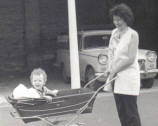
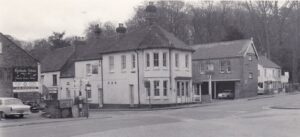
In 1974, the pub gained a Good Food award from Charles Wells and a favourite on the menu was “Sizzling Steak”. This was a prime fillet or sirloin from local butcher Pete Lowe, served on a red-hot iron bull-shaped skillet. That kind of meal is quite common now, but 50 years ago, it was a real novelty. The kitchen work was soon aided by the purchase of a microwave oven, another novelty for a 1970’s kitchen. This cost £405 in 1976, equating to about £2000 now. People would order something and ask for it to be microwaved just so they could try it. One of the chefs at the Swan would even bring over corn-on-the-cobs for us to cook for him, because it was so much quicker!
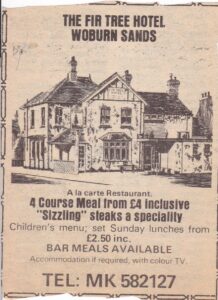
Also in 1974, after many years of arguments, the Woburn Sands War Memorial, which had been opened in 1919 in the road between the Fir Tree and The Swan, was carefully crated up and moved down the High Street to the gardens at the entrance to Shelton Court. It had been hit several times by cars and lorries and as traffic got larger and faster, it had become a dangerous obstacle.
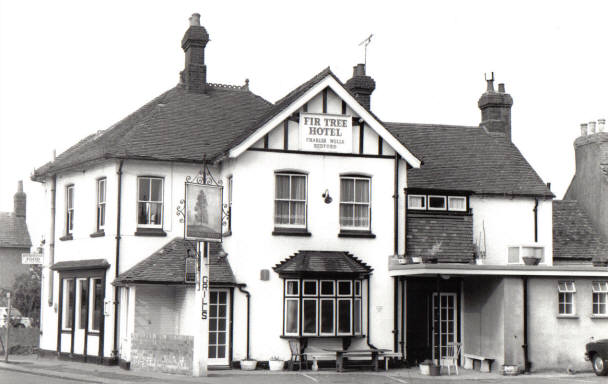
The unique restaurant décor was mentioned in Charles Wells’ Centenary book in 1976 and the Brewery finally gave Board approval to the conversion of the clubroom to accommodation which included a couple of new windows going into the side wall. The Hotel got some publicity with the opening of the five hotel rooms in the old hall in 1980 and letting of guest rooms in the main building itself then stopped. Also in 1980, the gas supply for the kitchen had come from a giant gas bottle stored in the yard, but it was finally converted to mains gas and extra grills fitted for the kitchen. The rent had now risen to £3780pa.
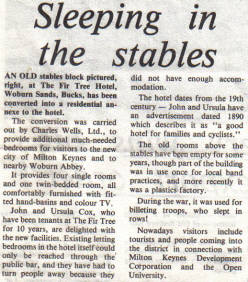
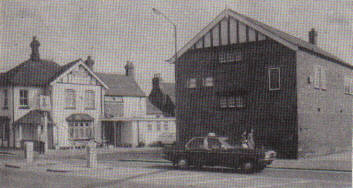
Across the road in Aspley Hill, some very old cottages known as Maypole Yard were demolished at the end of the 1960s and a new terrace of houses built. My parents purchased one and used the upstairs as additional letting bedrooms for a while. Guests were quite perplexed to check into the pub then be taken across the road! My parents were never prepared to pay any credit card commission, so all transactions had to be cash or cheque with a bank card, which was becoming difficult towards the end of their time there. The rooms were cheap – for many years the single rooms were £18 a night and the double or twin just £24.
In 1982, we adopted a Great Dane, which had been living in a block flats, the owners not having appreciated that it would grow so big. Duke, as we christened him, grew and grew until everyone who saw him was commenting on his height. The local press picked it up, as well as some interest from America I recall, it appearing in the National Enquirer. One day in 1984 the telephone rang and someone said they were from the BBC and wanted Duke to appear on TV. There had been a series of practical jokes between the regulars and my Dad at the time and he thought it was just another prank, so calmly demanded that, if it was real, they would send a car for us. The caller agreed. Right up to the day we thought it was a wind-up, until the Volvo estate arrived to collect us! It was a spot on the Russell Harty Show, along with Frankie Howard and Leo Sayer, where Duke was measured on air by TV vet David Taylor, to see if he broke the record for the tallest dog in Britain. I can now reveal that we were asked beforehand whether we wanted the record or not, as Duke was plainly taller than the existing record-holder, but they explained that it would mean signing a contract with the Guinness World Records and being available for promotional work with them. My parents didn’t want this (I have no idea why they turned down the publicity…) so declined and even in the programme you can see David Taylor sliding the scale on the measuring stick down, just a bit, before reading the measurement off. Duke was 22-months old at this point. Months later we were sent a £30 appearance fee from the BBC. You can see him on the show here: Duke, the big Great Dane on Russell Harty Show, January 1984 – YouTube
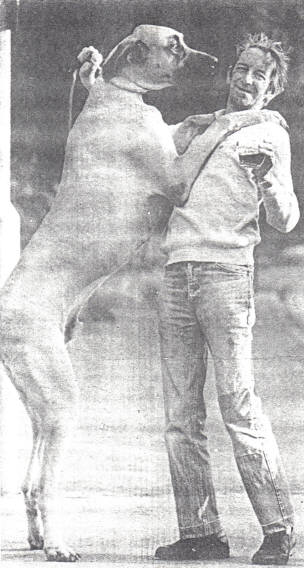
The Great Dane which held the record at that time lived in Buckinghamshire and the owners brought him in once to meet ours. As they stood looking at each other over the counter, they both looked a bit shocked! Duke stood 42 inches at the shoulder and in 1988 we raised money for Willen Hospice by having a “Guess the Weight” contest. The local fullers earth firm, Steetley Minerals, had scales for weighing pallets etc. and he weighed in at 14st 12lb. I should add that this was a lean dog, not a fat one, and as well as all the scraps generated at the Hotel, he had 5lb of fresh meat a day. Solomon Leadbetter won the sweep.
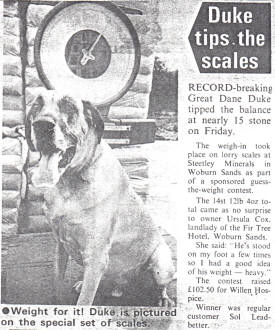
During this time we also had a piranha fish, called Albert, in a tank in the bar. One of the customers slipped a goldfish in, expecting it not to last very long, but they lived together very happily for months before the goldfish, who’d been christened Victoria, passed away and Albert was left pining and went off his food (frozen prawns) for several days.
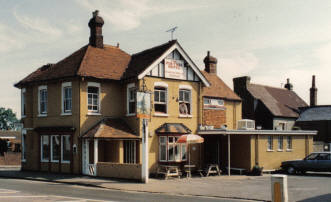
In 1983, the Hotel was repainted a curious shade of orange, much to our bafflement, but the decorating was down to the Brewery, so we had to live with it until 1990 when it returned to white. Their contract with the brewery stated the pub would be painted every four years, but they decided not to count the years it was done so it was six or seven years between redecs! That year, the entire roof was replaced and that summer we celebrated 20 years in occupation.
George Deverall was one of our most loyal customers. He lived in Downham Road and came in every night for many years. He rarely spoke, but when he did, you listened. He had fought in the First World War and had had some terrible experiences. In 1988 he was 90 and we organised a celebration for him. We asked the brewery for a barrel of his favourite beer but they sent a bottle of their own label whisky instead. Others in the picture are (l-r), my mum’s sister, Sonia, Andy Gallie, Paul ‘Alfie’ Taylor (front), Chris Bamford (back), Nick Andrew, Vince White, Ursula Cox and John Cox.
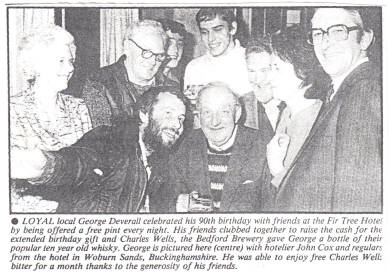
In March 1989, Chas. Wells unexpectedly gave 12 months’ notice to all their tenants by letter, siting the Monopolies and Mergers Commission report on the supply of beer in advance of a new Landlord and Tenant Act. This report said too few breweries were controlling the pub market and suggested that a brewery should have no more 2000 than pubs tenanted pubs. If enacted, breweries would be forced to swop to salaried Managers in their houses. People prepared to do a tenants job for a flat wage were thin on the ground and hundreds of pubs would be on the market for sale, severely disrupting the sector. Another section in the report specified that tied pubs should be allowed a Guest Ale which Wells thought was OK as long as they got to supply it, thereby controlling the price. Otherwise, another brewer would supply a beer at a cheap rate to other breweries pubs.
A week later another letter arrived, saying that the Chas. Wells Tenants Association had been supposed to let all tenants know that this was happening, but had not. The brewery promised to fight the implementation of the recommendations and had only issued notice as a “fall back solution“. In May, Wells said they would only rescind the notices if talks between the Department of Trace and Industry and the Breweries Society succeeded in removing the unpalatable sections of the Act. It was July before the Notices were withdrawn. It was a very unsettling time for everybody and my parents had started thinking they would be moving to their house in Aspley Hill in the near future.
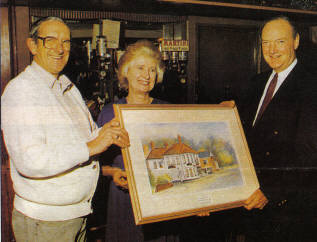
The regulars continued to support Willen Hospice and many charity events were organised for fund raising. In 1995, Charles Wells commissioned a painting of the Fir Tree as their gift for 25 years service and increased the rent to £12000pa. My mother had a very fractious relationship with the the brewery. They would write annually putting the rent up and she would demand an interview at the brewery. After a great deal of argument, it went up, but not by as much as they had originally suggested! Redecoration was a particular bugbear. As well as spinning the intervening periods out as long as possible, one year, the pub had the exterior painted in the pouring rain. A few weeks later, the new paint of course bubbled up and then started peeling off in huge sheets like sunburnt skin. My mother collected it up, folded it neatly and posted it back to the Chairman of Charles Wells, thanking him for the brief loan of the paint. The pub was repainted fairly swiftly…
It may have been my father sat behind the bar with his name over the door but it was my mother who did all the cooking, most of the serving and other business parts of the work. She did “the books” every Sunday night and claimed for every single thing possible as a business expense – even the dog food was claimed as he was protecting the business as a burglar deterrent! There was an intercom from the bar to kitchen to put orders in and a bell on the restaurant counter to summon John to fetch completed orders. John enjoyed himself behind the bar, telling tales of his merchant navy and flying days to the regulars, doing his crosswords and listening to Radio 2 – all with a drink in hand. Then his liver began to object to that lifestyle and started to fail. He was in and out of hospital a few times and never really recovered.
When my mother wrote and gave the brewery notice in July 1997, she said it was owing to a drop in trade due to the them not maintaining the building. Many of the wooden window frames and doors were now rotten. The pub had been flooded in a flash storm in May that year and the brewery had not even come out to see the damage, let alone offer assistance in any way, yet raised the rent again the same month, telling my parents this was due to the “prime site” of the pub.
In October 1997, John and Ursula retired to a nearby property in Aspley Hill, after 27 years of running the Fir Tree. The rent for 10 days tenancy of the pub now equalled what they had started out paying for a whole year. They did ask if I wanted to take over as a manager but I had my own plans with my fiancé by then, so we said no. There was a very good leaving party! I had grown up there and knew all the regulars as friends. My Dad enjoyed three years of retirement before he passed away in May 2000 and Mum died in 2011.
1997 to 1999 – Dean & Michael Readyhoff
The new landlords were Dean and Michael Reddyhoff, a father and son, who were also tenants at the Wheatsheaf in Bow Brickhill. Dean’s sister Gail was in day-to-day charge of the Fir Tree with her mother Pat, but they were unable to get an agreement from Charles Wells for the modernisation they wanted for the bars etc. and so they moved on in May 1999.
1999 to 2021 – Kevin & Dominic Brewer
The Hotel was closed for a major refit, with the interior completely redesigned, the upstairs accommodation altered and the Hotel rooms redecorated, before it was reopened in November, under Kevin and Helen Brewer, who also run the Station Inn in Woburn Sands.
The Hotel was themed around Golf, as the world famous Woburn Golf Course is just a couple of miles away and had memorabilia and pictures of the tournaments and stars. The beer was often commended by CAMRA and other beer guides. From Charles Wells’ “PintPot” magazine, February 2000:
“Family brewers Charles Wells have brought in another family of Brewers to run the newly refurbished Fir Tree at Woburn Sands on the Beds/Bucks border. Kevin and Helen Brewer are delighted to be part of the Charles Wells family: “They were so approachable and helpful we couldn’t refuse,” said the couple who also run the only other hotel in Woburn Sands, the Station Hotel, which they have under an Inntrepreneur lease. With Charles Wells the couple have a traditional tenancy which offers the enterprising the chance to launch a business, at a minimum of capital risk and with the back-up of a family firm which has been brewing and selling beer since 1876. The Fir Tree has been extensively restored and refurbished at a cost of £150,000. The works were completed in time for the Christmas season and have enabled the couple to be busy taking bookings from people and businesses in the new city of Milton Keynes and traditional area of Bedfordshire. Anthony Wallis, Sales Director with Charles Wells, who recently took over responsibility for the Tenanted Trade undertook his first “pulling of the first pint” at the official opening ceremony in November. He congratulated the architects and building contractors and the transformation of the building which dates back to 1889. A Woburn Sands pub originally called the Shoulder of Mutton and then the Greyhound was renamed the Fir Tree in 1786 when the Duke of Bedford planted his estate of Woburn nearby with a new forest of fir trees. In 1840 the pub moved to its current site close by the crossroads in the centre of Woburn Sands. Then a pub with its own brewhouse, the Fir Tree was by 1875 part of the Newport Pagnell Brewery Company which was bought by Charles Wells in 1920. In 1889 the old building was knocked down and the “new” hotel built which still stands today. The building which today houses bedrooms was at one time a hall where inquests and band practices were held. More recently the pub was run for more than 25 years by John and Ursula Cox who have now retired and live nearby. Ursula joined the opening ceremony at the pub and enjoyed being around the “other side” of the bar after a quarter of a century serving pints. Her son Paul was born in the pub and has written histories about the Fir Tree and Woburn Sands.
Refurbishment report by Company Architect Graham Stewart: Brewery project coordinator – Eric Jackson Consultants – Charter Partnership, John Creasey + Paul Ainge. Principal Contractor – Meadsway Construction, Graham Slade.”
Kevin’s first year in occupation was not without incident – in November 2000, in one week, he suffered a power cut, forcing him to close for a day, then a gas leak, also prompting a close-down, then an Anglian Water van burst into flames where it was parked outside the Hotel wall in Aspley Hill, causing damage. All this, and his Station Hotel was flooded the same week by an overflowing stream and trees brought down by strong winds crushed his caravan! Thankfully, the pub survived all the mayhem.
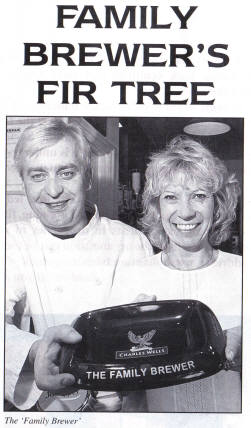
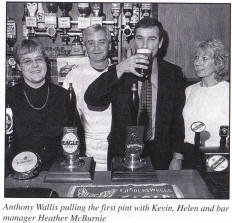
Running of the pub was later taken over by Kevin’s son, Dominic. In 2013, another extensive remodeling occurred and the Golf theme which had been slowly removed over the years was dropped completely. The Fir Tree Hotel was officially renamed as the Fir Tree Inn, which had last been used for the pub in 1889. The external walls were decorated with transferred signage and the old meeting room, which had been converted to bedrooms in 1980, was fully externally painted for the first time. Inside, the inn was decorated with antique images of the pub and some adverts from old newspapers, which I was pleased to be asked to supply. The grand re-opening was 21st November, with a new inn sign and external seating area.
The 2020 Covid pandemic forced all pubs to close for months on end and then only reopen with severe restrictions in numbers of customers. The Brewer family concentrated on keeping the Station Inn afloat and mothballed the Fir Tree. They then decided to end their involvement with it.
2021 to present – Emilie Geary
Emilie Geary had been working for the Brewer’s at the Fir Tree and formed a partnership with an international events organiser, Lynne Roberts, who lives nearby, to take on the pub. It was redecorated with a modern theme (alongside some of my old photos still) before reopening in October 2021. They have utilised the carpark and space under the bedrooms as new external seating and continued in the best traditions of supplying good beer and quality food to their customers, ensuring the Fir Tree still offers a welcome to all who call in. Long may it continue!
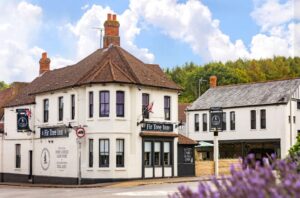
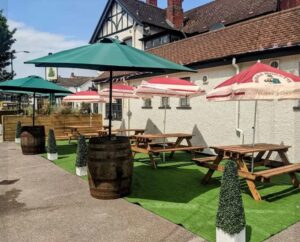
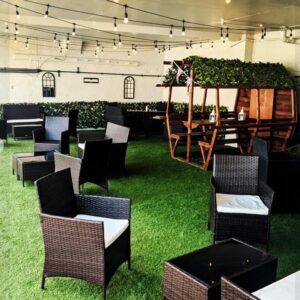
…And so that’s the 270+ year story of one pub, in two places, with three names. If you can add to any of the details here, or have connections to any of the past landlords, I would be very pleased to hear from you.
Page last updated Mar. 2023.
